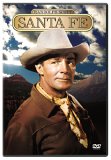| Reviews & Columns |
|
Reviews DVD TV on DVD Blu-ray 4K UHD International DVDs In Theaters Reviews by Studio Video Games Features Collector Series DVDs Easter Egg Database Interviews DVD Talk Radio Feature Articles Columns Anime Talk DVD Savant Horror DVDs The M.O.D. Squad Art House HD Talk Silent DVD
|
DVD Talk Forum |
|
|
| Resources |
|
DVD Price Search Customer Service #'s RCE Info Links |
|
Columns
|
|
|
Santa Fe
Scott is Britt Canfield, the eldest son of a wealthy Virginia plantation family that has lost everything in the War Between the States. He's ready to move on with his life, but not so brothers Clint (John Archer), Tom (Peter Thompson), and young Terry (Jerome Courtland). At a saloon a bunch of drunk Union soldiers taunt the former Johnny Rebs, violence erupts and one of the soldiers ends up dead, driving the Canfields westward and forcing them to live under assumed names.
Britt eventually goes to work for the Santa Fe Railroad during its push from Kansas to New Mexico. Hired by Dave Baxter (Warner Anderson), Britt works closely with paymaster Judith (Janis Carter, in too contemporary make-up), and all three become real Manifest Destiny types, with Britt and Judith falling in love as well.
Clint, Tom, and Terry, meanwhile, fall in with greedy Cole Sanders (Roy Roberts), who first corrupts the railroad workers with fly-by-night gambling and whiskey tents set-up near the construction sites. Later, Cole raises the stakes by planning to rob the Santa Fe's payroll. The bitter Canfield brothers join in, figuring those damn Yankees got it coming. All this sets brother and against brother as Britt, unable to set his brothers straight, remains loyal to the Santa Fe Railroad while the other Canfields ride headlong into disaster.
Despite a great chase in the first act, when the Canfields flee the scene of the Union soldier's murder, there's precious little action in Santa Fe, with most of the film devoted to colorful scenes of railroad building, complete with vintage train engines. (Train buffs will likely enjoy the film for this alone.) The use of these restored train cars and myriad costumed extras, along with the added benefit of Technicolor, probably pushed the budget slightly over $1 million, making it on the expensive side for the Scott Western. But colorful scenes do not a film make.
The business with the brothers isn't compelling. If Scott's Britt can get over their losses, why can't they? Their reasoning is faulty, and Britt's common sense falls on deaf ears. Scott's regular screenwriter, Kenneth Gamet (adapting James Vance Marshall's novel) resolves this conflict most unimaginatively, and in a way that makes the picture seem like it was all a waste of time.
Not helping matters is the general colorlessness of the actors, and the blandly competent direction. The former actor Irving Pichel (best remembered as Sandor in Dracula's Daughter) had also been a director dating back to The Most Dangerous Game (1932) and She (1935), and had just come off an enormous hit, producer George Pal's influential Destination Moon (1950). Pichel (pronounced PEE-kal) brought over the two leads from that film, Warner Anderson and John Archer, but neither has much personality. Third brother Jerome Courtland is a bit better; he went on to a long career as a film producer (including some latter-day Disney features) and as one of the more prolific television directors of the late-1970s and early-1980s.
In scenes that play as if they had been conceived for Laurel and Hardy, Billy House and Olin Howlin (The Blob) offer amusing comedy relief as the Santa Fe line's fat engineer and his thin, not-too-bright assistant. As was often the case with Laurel and Hardy, Howlin's character appears dense but is brighter than he looks - he's a card shark and can speak fluent Sioux when called upon. In any event they're far more interesting than any of Britt's brothers. (Busy minor character man Frank Ferguson appears unbilled in what was surely the most glamorous part of his long career: Bat Masterson.)
The film's attitude about the railroad builders and their struggles is naive at best. Indians threatened by the arrival of the steam engine are happily placated once the chief gets to drive the engine along a short stretch of track ("Chief," Biff proclaims, "maybe someday we'll name a train after you!"), while Dave, Judith, and Britt see only the Greater Good the railroad will bring without considering the millions of dollars the railroad company stands to profit from their hard work.
Video & Audio
After an unusually weather-beaten Columbia logo, Santa Fe springs to life in its Technicolor glory. It's not an exceptional full-frame transfer, but it's fairly good. The colors are bright and the image reasonably sharp. The mono sound is fine also. Optional English and Japanese subtitles are available. There are no Extra Features.
Parting Thoughts
Santa Fe is a picture that will appeal mainly to train buffs, hard-core Western buffs, and those curious about what the director and stars of Destination Moon did next. It's competently made, but unmemorable.
Stuart Galbraith IV is a Kyoto-based film historian whose work includes The Emperor and the Wolf - The Lives and Films of Akira Kurosawa and Toshiro Mifune and Taschen's forthcoming Cinema Nippon. Visit Stuart's Cine Blogarama here.
|
| Popular Reviews |
| Sponsored Links |
|
|
| Sponsored Links |
|
|
| Release List | Reviews | Shop | Newsletter | Forum | DVD Giveaways | Blu-Ray | Advertise |
|
Copyright 2024 DVDTalk.com All Rights Reserved. Legal Info, Privacy Policy, Terms of Use,
Manage Preferences,
Your Privacy Choices | |||||||













